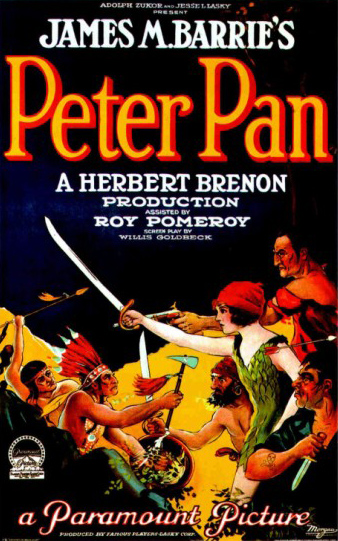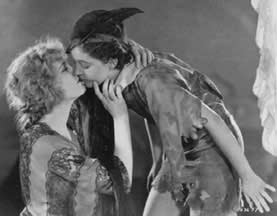The first half hour of Herbert Brennon’s Peter Pan is an extraordinary piece of filmmaking, masterful in a delicate and unusual way.
Almost all of it takes place in the Darling nursery, on a set that is shot
from basically one angle and seems designed to suggest a theatrical
stage. I’m guessing that this was a deliberate strategy, meant to
associate the film with the celebrated stage productions of Barrie’s
play, even though it was somewhat anachronistic for a film from 1924. Brennon,
however, has taken this limitation as a challenge, and in his own
subtle way has mastered it.
The long shots of the set, with a frame that seems to mimic a proscenium
arch, are lit with extraordinary care by James Wong Howe. He achieves a
stunning impression of depth in the way his lights define discrete
spaces within the room and sculpt individual figures within those
spaces. Brennon’s choreography of movement within the constricted
location reinforces the stereometric nature of Howe’s lighting.
Slowly, and with great subtlety, Brennon allows his camera to tentatively
explore this space from slightly different angles — almost like a
tease. We never feel that our general sense of watching a stage play is
challenged — but seem suddenly, briefly transported up onto the stage
for a privileged view of the action, as in a dream.
The lighting shifts progressively throughout the sequence in a decidedly
expressionistic way — from the high illumination of the opening to the
more atmospheric shadows of the room lit by the nightlights. Then Peter
appears, and the gears shift radically. Wendy sews Peter’s shadow back
on in a gorgeous half-silhouette downstage, then Peter dances with his
shadow in a circle of light, shot from slightly above, that seems to
have no logical source.
When Peter teaches the Darling children to fly, our head-on view of the set
is explicitly violated as we see one of the boys flying up towards a
camera placed near the ceiling and shooting in a near-reverse angle to
the one we’ve mostly been watching from. It’s a shocking and magical
shift — echoing the shock and magic of the child’s first flight.

Alas, the rest of the film, in Never Land, is not as magical as this first
act. The Catalina locations, the studio forest and underground lair,
the actors in animal costumes and the actors in human costumes never
quite cohere into a vision, despite many delightful passages. The final
action sequence on the pirate ship is confused and dull — until the
wondrously choreographed sword battle between the Lost Boys and the
pirates lifts it all into magic once again.
The special effects vary in quality, too. Most of the wire-work flying is
well done, but the flight of the pirate ship at the end is
underwhelming, and some of the superimpositions involving Tinkerbell
are poorly executed.
This is a title-heavy film, but the titles are faithful to Barrie’s truly
charming text, tastefully selected and arranged.
The general result is a very uneven but endlessly fascinating film.
Brennon’s vaguely perverse sensibility, always delivered with a
gossamer touch, is evident most especially in his use and appreciation
of Betty Bronson in the title role. She dances the part in a frankly
sensual way, and she is unmistakably and delightfully female — which
allows Brennon to exploit an unmentionable eroticism in certain
passages.

The half-silhouetted shadow-sewing sequence between Wendy and
Peter has the quality of a sexual encounter, and there is nothing
innocent in the numerous kissing scenes — between Bronson and Mary Brian,
Bronson and Anna Mae Wong, Bronson and Esther Ralston.
When Peter lies down to sleep on the leaf bed after Wendy and the Lost Boys have left the underground lair, Bronson is photographed in a languorous and sensual and purely
feminine pose — which gives Captain Hook’s spying on her a wholly different spin than the narrative might suggest. Hook’s hatred of Peter reads as thwarted lust, pure and simple. He knows as well as we do that the creature on that bed is a woman.
Sex in silent movies was a lot more interesting than it is in movies today.
